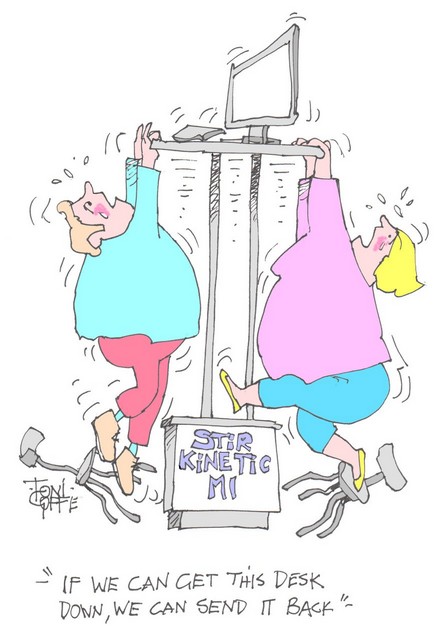SEDENTARY BEHAVIOUR Part 2
Sedentary behaviour and cardiovascular disease
The more you sit about the higher the risk of developing cardiovascular disease and diabetes – independently of the amount of exercise you take when not sitting about. The extent of the damage from sedentary behaviour has been quantified by a study of the coronary calcium scores in Dallas heart patients. This score indicates the amount of calcium detectable in coronary arteries and is a good indicator of the presence of coronary narrowing with its attendant risks of heart attacks and sudden death. For this group of over 2,000 patients, each hour of sedentary time per day on average was associated with a 14% increase in coronary artery calcification. TV viewing time has also been under the microscope. For every additional hour daily of watching the goggle-box there is an increase in the risk of cardiovascular disease of 3% and an increase in BMI of 0.54. Other conditions which have been shown to be aggravated or even caused by too much sitting about include obesity, some cancers and all cause mortality.
The cost of sedentary behaviour
Sedentary behaviour brings a substantial cost to the national purse. A study of sedentary behaviour for the year 2016-2017 estimated that the cost to the NHS was £700 million per annum with most of this due to the increased prevalence of cardiovascular disease (£424 million), type 2 diabetes (£281 million), colon cancer (£30 million), lung cancer (£19 million) and cancer of the uterus (£7 million). If prolonged sedentary behaviour was eliminated, 69 276 UK premature deaths might have been avoided in 2016.
Getting us off our backsides
How best to reduce sedentary behaviour then? Fidgeting is very effective. And there is no shortage of ideas given by the authors of the Dallas Heart Study paper – take a walk at lunchtime, pace about when on the phone, take the stairs not the lift, use a pedometer as a prompt to keep moving. Others have suggested using more “active travel” such as cycling to work, getting off the bus a stop or two stops early, walking rather than driving for short trips, getting up and moving about during TV commercial breaks.
Exercise at work
There is a move in some companies to introduce standing work stations in place of the traditional desk and chair. The Stand More At Work (SMArT) intervention is an approach adopted by one NHS Trust. However standing instead of sitting may not be enough – and an active workstation has been invented. The Stir Kinetic MI is a computerised desk which detects when its owner has been sitting for too long and moves up and down a few inches to force them to stand up. It can be programmed to account for the height of the user and the frequency of movement required – at just £2000 surely a lifesaving snip!
The workplace is where we are used to spending much of our life – not as much as before the pandemic but bound to increase again over the coming months. Remember all the possibilities for keeping active while earning our crust. Many more ideas are given at www.choosetonic.co.uk
PS
Graham Lawton, a new scientist writer, has written a book about all the lifestyle determinants of later life disease and premature mortality. Its title is “This book could save your life” – and it might just do that!
A good introduction to his thinking is given by a talk he gives, accessible by going to
newscientist.com/healthy-life
You will need to register which then gives you free access to the talk. It lasts about 1 hour which includes Q&A. Listen to the end.
Subscribe to the blog
Categories
- Accelerometer
- Alzheimer's disease
- Blood pressure
- BMI
- Cancer
- Complications
- Coronary disease
- Cycling
- Dementia
- Diabetes
- Events
- Evidence
- Exercise promotion
- Frailty
- Healthspan
- Hearty News
- Hypertension
- Ill effects
- Infections
- Lifespan
- Lipids
- Lung disease
- Mental health
- Mental health
- Muscles
- Obesity
- Osteoporosis
- Oxygen uptake
- Parkinson's Disease
- Physical activity
- Physical fitness
- Pregnancy
- Running
- Sedentary behaviour
- Strength training
- Stroke
- Uncategorized
- Walking


